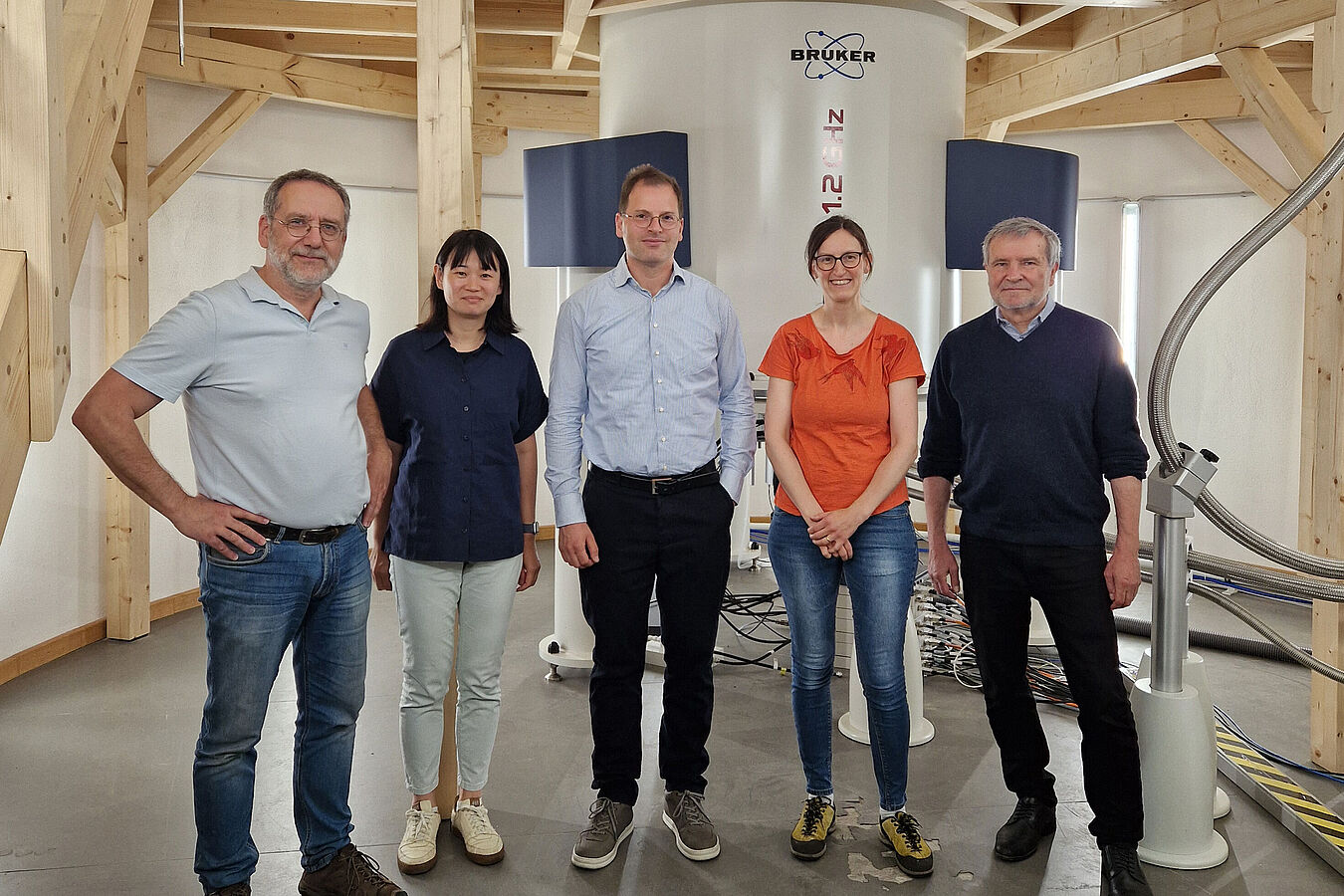A new NMR spectrometer has been in operation at the Leibniz-Forschungsinstitut für Molekulare Pharmakologie (FMP) since the end of May. What makes it special is that it is based on a new type of ceramic high-temperature superconductor. Peter Schmieder, head of the NMR technology platform at the FMP, explains the technology behind it and the capabilities of the new device.

Proudly presenting the new NMR spectrometer at the institute. From left to right: Dr. Peter Schmieder, Prof. Dr. Han Sun, Prof. Dr. Adam Lange, Dr. Sigrid Milles, Prof. Dr. Hartmut Oschkinat. | Foto: Silke Oßwald
The first NMR spectrometer was to be installed in the basement, says Peter Schmieder. However, magnets of this magnitude have a very strong magnetic field, and it would have been impractical to clear the ground floor to prevent anyone from working in the field's vicinity. "So, we constructed a separate building for the spectrometer. Later, other devices found a place there, and soon a second building was added," reports the head of the NMR technology platform.
Now, there is no more space in the second building either, and a third one had to be built for the new NMR spectrometer. The device is the eleventh of its kind since researchers at the FMP began conducting studies using nuclear magnetic resonance (NMR) spectroscopy in 1995. Peter Schmieder has been involved from the beginning. He has supervised the construction of each of the devices, all of which are still in operation.
The new device is special because it employs a technology recognized with the Nobel Prize in Physics in 1987: the high-temperature superconductor. "High-temperature means the material develops superconducting properties at a temperature above minus 200 degrees Celsius," explains Peter Schmieder. In this state, the inside of the magnet is free from electrical resistance and provides a stable field after charging without further power supply for many years (persistent magnet). The oldest magnet at the FMP, still with conventional superconductors, has maintained its field for a quarter of a century. This allows for highly precise analyses of increasingly complex biological systems, such as protein structures. "The quality of the measurement, meaning its sensitivity and the resolution in the spectra, depends on the field strength of the magnet - the stronger, the better," says Peter Schmieder.
The magnet in the new device achieves the currently highest possible stable magnetic field of 28 Tesla, which corresponds to a resonance frequency of 1.2 gigahertz (GHz), a 20 percent higher resonance frequency than what could be achieved with conventional superconductors. This is due to the material used: the innermost part of the coil was made with ceramic superconductors, a tricky task because the material is more brittle than metal. The manufacturer worked on this development for over a decade. However, the operating temperature of the new superconductors remains at -271 °C to ensure the material can support the strong magnetic field. The new NMR device on the Buch campus is one of only ten that have been put into operation worldwide so far.
The 28-Tesla field is a million times stronger than Earth's magnetic field. Since the magnets in the NMR devices are shielded and the generated magnetic fields are static and not fluctuating, they pose no problems for healthy people without pacemakers. However, Peter Schmieder and his team leave mobile phones and watches at the door before entering one of the rooms with the NMR spectrometers.
The setup of the new NMR device is now complete. The 8-ton magnet was moved into the building on an air cushion and then positioned vertically. After the setup was completed, it had to be cooled down. "That alone took three weeks. You do it very slowly to avoid mechanical stresses in the coil," reports Peter Schmieder. When the coil reaches a temperature of two Kelvin (-271.15 degrees Celsius or two degrees Celsius above absolute zero), the magnet is charged. This is the tricky part: if something goes wrong, the coil loses its superconductivity, the cooling medium helium warms up and evaporates into the atmosphere, and the entire - expensive and lengthy - process has to be restarted. "But everything went according to plan, the magnet is on field, meaning it has reached its field of 28 Tesla," Peter Schmieder is pleased to report. Afterwards, the hardware was tested to check if the device's specifications regarding electronics and measuring equipment were met.
Since the end of May, the test operation with the first scientific measurements has been running.
"The primary challenge in protein NMR spectroscopy lies in the numerous signals that exhibit only minor differences from one another. This is why achieving high resolution is crucial," says Peter Schmieder. Additionally, this technology is particularly suitable for determining the mobility of proteins. The experimental setup for measurements in solutions or in solids is different, which is why the old NMR devices at the FMP are used for one measurement type each - currently five for solid-state measurements and five for solution measurements. However, the new device is designed to be used for both measurement types. This allows for a wide variety of investigations to be carried out with the new state-of-the-art magnet. The main users of the new device will be the NMR groups working at the FMP. Adam Lange's group uses solid-state NMR to investigate the structure and dynamics of pharmacologically relevant membrane proteins, while in Sigrid Milles' group solution NMR is used to characterize intrinsically disordered proteins (IDPs). Han Sun's group utilizes anisotropic NMR to determine the structure and stereochemistry of small molecules and peptides, while Hartmut Oschkinat's group characterizes biofilm proteins using solution and solid-state NMR.






